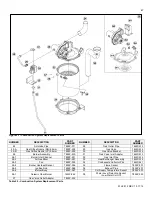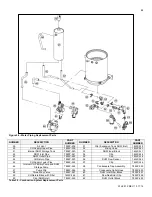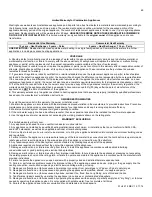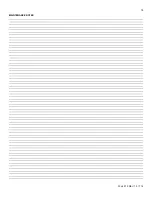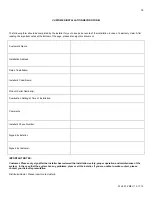
62
WHL-012 REV. 12.17.14
Have leaks fixed at once by a qualified service technician. Failure to comply could result in substantial property damage, severe
personal injury, or death.
Operate Pressure Relief Valve
Before proceeding, verify that the relief valve outlet has been piped to a safe place of discharge, avoiding any possibility of
scalding from hot water.
To avoid water damage or scalding due to relief valve operation, a discharge line must be connected to the valve outlet and directed to
a safe place of disposal. This discharge line must be installed by a qualified service technician or heating/plumbing installer in
accordance with the appliance installation manual. The discharge line must be terminated so as to eliminate possibility of severe burns
or property damage should the valve discharge.
Read the temperature and pressure gauge to ensure the system
is pressurized. Minimum is 10 psi. Maximum is 25 psi. Lift the
relief valve top lever slightly, allowing water to relieve through the
valve and discharge piping.
If water flows freely, release the lever and allow the valve to seat.
Watch the end of the relief valve discharge pipe to ensure that
the valve does not weep after the line has had time to drain. If the
valve weeps, lift the lever again to attempt to clean the valve
seat. If the valve does not properly seat and continues to weep,
contact a qualified service technician to inspect the valve and
system.
If water does not flow from the valve when you completely lift the
lever, the valve or discharge line may be blocked. Immediately
shut the appliance down per instructions on page 2 and call a
qualified service technician to inspect the valve and system.
Check the Burner
Clean the exterior of the burner.
Flushing the CH Closed Loop Heat Exchanger
Flushing the heat exchanger is a complicated procedure that should only
be performed by a qualified service technician. It is recommended to flush
the heat exchanger annually if water hardness exceeds 12 grains per
gallon (considered extremely hard water). If water hardness falls below 12
grains per gallon it is recommended to flush the heat exchanger every two
to three years.
NOTE:
Improper maintenance WILL VOID appliance warranty.
1. Disconnect electrical power to the appliance.
2. Close the shutoff valves on both CH supply and CH return lines (V1 and
V2). See Figure 47.
3. Connect one hose (D1, Figure 48) to the valve (V3) and place the free
end in a bucket. Connect one of the hoses (D3) to the circulation pump
outlet and the cold water inlet line to valve V4. Connect the other hose
(D2) to the circulation pump inlet and place the free end in the bucket.
4. Pour tankless cleaning solution into the bucket. Use an FDA approved
cleaner for potable systems on the heat exchanger. Place the drain hose
(D1) and hose D2 to the pump inlet in the cleaning solution.
5. Open service valves (V3 and V4) on the hot water outlet and cold water inlet lines.
6. Turn on the circulation pump. Operate the pump and allow the cleaning solution to circulate through the appliance for at least 1 hour
at a rate of 4 gallons per minute.
Figure 47
– Valve Detail
Figure 48
– Hose Connection Detail
Содержание WBRCLP140F
Страница 2: ...2 WHL 012 REV 12 17 14 ...
Страница 38: ...38 WHL 012 REV 12 17 14 Figure 26 Electrical Wiring Diagram ...
Страница 39: ...39 WHL 012 REV 12 17 14 Figure 27 Ladder Diagram ...
Страница 73: ...73 WHL 012 REV 12 17 14 ...
Страница 74: ...74 WHL 012 REV 12 17 14 ...
Страница 75: ...75 WHL 012 REV 12 17 14 MAINTENANCE NOTES ...




















